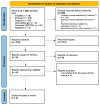Quantitative Flow Ratio-Guided vs. Angiography-Guided Percutaneous Coronary Intervention: A Systematic Review and Meta-Analysis of One-Year Clinical Outcomes
- PMID: 40725710
- PMCID: PMC12295738
- DOI: 10.3390/jcm14145015
Quantitative Flow Ratio-Guided vs. Angiography-Guided Percutaneous Coronary Intervention: A Systematic Review and Meta-Analysis of One-Year Clinical Outcomes
Abstract
Background: Quantitative Flow Ratio (QFR) is a novel, wire-free, and hyperemia-free physiological assessment for guiding Percutaneous Coronary Intervention (PCI), which may offer advantages over traditional angiography-guided PCI. This systematic review with meta-analysis compares clinical outcomes after one year in patients who underwent QFR-guided versus angiography-guided PCI. Methods: This study was conducted following the Preferred Reporting Items for Systematic Reviews and Meta-Analyses (PRISMA) guidelines and was registered on 4 November 2024 in PROSPERO (ID: CRD42024609799). A systematic search was performed across multiple databases to identify clinical trials comparing QFR-guided and angiography-guided PCI. Random-effects models were used to assess one-year outcomes of major adverse cardiovascular events (MACEs), revascularization, and rehospitalization, with heterogeneity measured using I2, H2, and Cochran's Q statistics. Study quality was evaluated using the Cochrane Risk of Bias 2 (RoB 2) tool. Results: Compared to traditional angiography-guided PCI, QFR-guided PCI was associated with numerically lower but statistically non-significant risks of MACEs (risk difference: -0.08, 95% CI: -0.20 to 0.04), revascularization (risk difference: -0.02, 95% CI: -0.08 to 0.03), and rehospitalization (risk difference: -0.02, 95% CI: -0.08 to 0.04) over one year. Substantial heterogeneity was observed for MACEs (I2 = 84.95%, H2 = 6.64) and revascularization (I2 = 94.18%, H2 = 17.18), whereas rehospitalization exhibited low heterogeneity (I2 = 17.17%, H2 = 1.21). The risk of bias was assessed by the RoB 2 tool, which revealed low to some concern risk of bias across key domains. Conclusions: Quantitative Flow Ratio (QFR) has demonstrated comparable one-year clinical outcomes to traditional angiography for PCI guidance, with a trend toward improved results. However, the high heterogeneity among studies and the risk of bias necessitate the need for larger, high-quality trials to validate these findings.
Keywords: FFR; MACE; QFR-guided PCI; iFR; percutaneous coronary intervention (PCI); quantitative flow ratio (QFR); revascularization; vFFR.
Conflict of interest statement
The authors declare no conflicts of interest.
Figures
Similar articles
-
Comparing the adverse clinical outcomes associated with fraction flow reserve-guided versus angiography-guided percutaneous coronary intervention: a systematic review and meta-analysis of randomized controlled trials.BMC Cardiovasc Disord. 2016 Dec 3;16(1):249. doi: 10.1186/s12872-016-0427-8. BMC Cardiovasc Disord. 2016. PMID: 27912739 Free PMC article.
-
Falls prevention interventions for community-dwelling older adults: systematic review and meta-analysis of benefits, harms, and patient values and preferences.Syst Rev. 2024 Nov 26;13(1):289. doi: 10.1186/s13643-024-02681-3. Syst Rev. 2024. PMID: 39593159 Free PMC article.
-
Comparison of intravascular imaging, physiological assessment and angiography for coronary revascularization in acute coronary syndrome: a systematic review and network meta-analysis.Front Cardiovasc Med. 2025 Jul 21;12:1604050. doi: 10.3389/fcvm.2025.1604050. eCollection 2025. Front Cardiovasc Med. 2025. PMID: 40761230 Free PMC article.
-
Two-year outcomes of quantitative flow ratio-based physiology-guided percutaneous coronary intervention in patients with low-risk acute coronary syndrome: a prespecified secondary analysis of FAVOR III China.EClinicalMedicine. 2025 Aug 30;88:103461. doi: 10.1016/j.eclinm.2025.103461. eCollection 2025 Oct. EClinicalMedicine. 2025. PMID: 40926902 Free PMC article.
-
Assessment of Coronary Stenoses for Percutaneous Coronary Intervention: A Systematic Review and Network Meta-Analysis of Randomized Trials.Am J Cardiol. 2024 Jul 15;223:29-39. doi: 10.1016/j.amjcard.2024.05.019. Epub 2024 May 18. Am J Cardiol. 2024. PMID: 38768846
References
-
- Layland J., Oldroyd K.G., Curzen N., Sood A., Balachandran K., Das R., Junejo S., Ahmed N., Lee M.M.Y., Shaukat A., et al. Fractional Flow Reserve vs. Angiography in Guiding Management to Optimize Outcomes in Non-ST-Segment Elevation Myocardial Infarction: The British Heart Foundation FAMOUS-NSTEMI Randomized Trial. Eur. Heart J. 2015;36:100–111. doi: 10.1093/eurheartj/ehu338. - DOI - PMC - PubMed
-
- Fearon W.F., Bornschein B., Tonino P.A.L., Gothe R.M., De Bruyne B., Pijls N.H.J., Siebert U. Fractional Flow Reserve Versus Angiography for Multivessel Evaluation (FAME) Study Investigators Economic Evaluation of Fractional Flow Reserve-Guided Percutaneous Coronary Intervention in Patients with Multivessel Disease. Circulation. 2010;122:2545–2550. doi: 10.1161/CIRCULATIONAHA.109.925396. - DOI - PubMed
-
- van de Hoef T.P., Nolte F., EchavarrÍa-Pinto M., van Lavieren M.A., Damman P., Chamuleau S.A.J., Voskuil M., Verberne H.J., Henriques J.P.S., van Eck-Smit B.L.F., et al. Impact of Hyperaemic Microvascular Resistance on Fractional Flow Reserve Measurements in Patients with Stable Coronary Artery Disease: Insights from Combined Stenosis and Microvascular Resistance Assessment. Heart. 2014;100:951–959. doi: 10.1136/heartjnl-2013-305124. - DOI - PubMed
-
- Tanaka H., Matsumoto H., Takahashi H., Hosonuma M., Sato S., Ogura K., Oishi Y., Masaki R., Sakai K., Sekimoto T., et al. Linear Concentration-Response Relationship of Serum Caffeine with Adenosine-Induced Fractional Flow Reserve Overestimation: A Comparison with Papaverine. EuroIntervention. 2021;17:e925–e931. doi: 10.4244/EIJ-D-21-00453. - DOI - PMC - PubMed
Publication types
LinkOut - more resources
Full Text Sources
Miscellaneous






